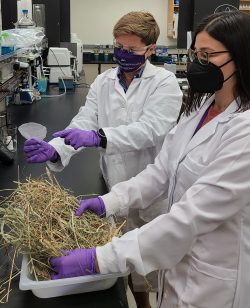
Earlier this year, the United States officially re-entered the Paris Climate Agreement, an international accord that brings many nations together to address climate change. This reconciliation puts the U.S. on track to adopt cleaner energy policies in the pursuit of eventual carbon neutrality. This return also reinforces the importance of advancing environmental research to decrease our dependence on fossil fuels, which is critical to curbing carbon dioxide emissions.
One strong alternative to fossil fuels that has gained momentum in the past years are sustainable aviation fuels, know as SAFs, and the School of Environmental and Forest Sciences is playing a key role in understanding how to remove production and economic barriers related to their development. Currently, low-carbon SAF is produced from waste fats and oils, yet there is only a limited supply of these resources. And switching to virgin materials such as palm oil or rapeseed oil raises food versus fuel and land use change issues.
So why focus on biofuels, particularly jet fuels? The global aviation industry is currently responsible for the generation of around 2% of all human-produced carbon emissions, as well as 12% of all emissions from transportation. Considering that emissions will only keep growing in the future as more and more planes and airports are built, this industry finds itself in need of solutions when it comes to cutting carbon emissions. Electrically powered planes and the use of sustainably produced hydrogen for jet fuel are other potential low-carbon alternatives for the aviation industry, but there are limitations to both of these technologies. Additionally, switching from the current hydrocarbon-based fuels will take time and be costly. In the near term, low-carbon aviation fuel can be produced from biomass resources.
“Sustainable aviation fuel has one of the largest market pulls in the biofuels sector,” says environmental and forest sciences professor Rick Gustafson, a leading researcher on biofuels. “Airlines are eager to lower their carbon footprint. However, aviation fuel is a challenging product to produce since airlines need to keep their fuel costs low and the fuel has stringent technical requirements to be safe.”
Propelled by a $40 million grant awarded by the U.S. Department of Agriculture, Gustafson and his colleagues are currently conducting research to produce SAF and co-products from biomass resources such as wheat straw, the leftover biomass after corn harvest (known as stover) and poplar wood grown on tree farms. Biomass from these sources has the potential to generate large volumes of SAF; in fact, the Department of Energy estimates approximately a billion tons of sustainably sourced biomass is available for the production of fuels and chemicals.
The grant, awarded in 2010, allowed Gustafson’s team and collaborators to establish the Advanced Hardwood Biofuels (AHB) consortium, which laid the foundation for a biofuels industry using sustainably sourced poplar wood. The research demonstrated the multiple environmental, economic and social benefits of the biofuels industry, yet also demonstrated the economic challenges of establishing such an industry, especially when oil is inexpensive to produce. The path forward will require low-cost feedstock materials, the development of high-value co-products and solid policy support.

The current UW research has four primary initiatives: 1) develop biomass production methods that provide additional ecosystem services, such as cleaning roadside stormwater, 2) develop a range of valuable and environmentally friendly products from biomass resources, like nano materials to replace the petroleum-based plastics that are polluting our oceans, 3) develop integrated, low-impact processes that produce low-carbon fuels and environmentally friendly products so the overall enterprise has excellent economic and environmental performance, and 4) outline policy mechanisms that can enable the establishment of a robust bio-based industry.
“Even a modest bio-refinery will cost hundreds of millions of dollars. With that kind of capital investment requirement, the technology has to work, the economics have to be solid and you need a consistent, workable policy framework,” says Gustafson.
The AHB program led to a feasibility study for establishing a “Biohub” — a term coined by Gustafson and his colleagues — in Lewis County, Washington. A Biohub is a collection of integrated industries that use biomass as their ultimate feedstock. Lewis County was identified early on in the AHB project as a good location since it has a large, low-cost land base to grow biomass and a good foundation for infrastructure. Leaders in Lewis County welcomed these new economic opportunities, which a strong bio-based industry could bring to the region by providing employment in conversion facilities, on dedicated biomass farms that supply the feedstocks and in the additional enterprises that support manufacturing. In short, it provides a pathway for rural communities to enjoy economic growth while supplying sustainable fuels, chemicals and products, as well as multiple ecosystem services.
“A low carbon future is within our reach,” says Gustafson. “We just need to go after it.”

